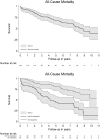Chronic Periprosthetic Hip Joint Infection. A Retrospective, Observational Study on the Treatment Strategy and Prognosis in 130 Non-Selected Patients
- PMID: 27658252
- PMCID: PMC5033335
- DOI: 10.1371/journal.pone.0163457
Chronic Periprosthetic Hip Joint Infection. A Retrospective, Observational Study on the Treatment Strategy and Prognosis in 130 Non-Selected Patients
Abstract
Introduction: Limited information is available regarding the treatment strategy and prognosis of non-selected patients treated for chronic periprosthetic hip joint infection. Such information is important as no head-to-head studies on treatment strategies are available. The purpose of this study is to report on the treatment strategy and prognosis of a non-selected, consecutive patient population.
Methods: We identified 130 patients in the National Patient Registry, consecutively treated for a chronic periprosthetic hip joint infection between 2003-2008 at 11 departments of orthopaedic surgery. We extracted information regarding patient demographics, treatment and outcome. 82 patients were re-implanted in a two-stage revision (national standard), the remaining 48 were not re-implanted in a two-stage revision. We were able to collect up-to-date information on all patients to date of death or medical chart review with a minimum of 5 years follow-up by the nationwide electronic patient record system.
Results: After primary revision surgery, 53 patients (41%) had a spacer in situ, 64 (50%) had a resection arthroplasty and 13 (9%) did not have the infected implant removed. 63% were re-implanted in a two-stage revision. Re-implantation was performed after an interim period of 14 weeks (IQR 10-18). Patients re-implanted were younger (p-value 0.0006), had a lower CCS score (p-value 0.005), a lower ASA score (p-value 0.0001) and a 68% lower mortality risk in the follow-up period (p-value <0.00001). After adjusting for selected confounders, the mortality risk was no longer significantly different. The 5-year re-infection rate after re-implantation was 14.6% (95%CI 8.0-23.1). Re-infections occurred mainly within 3 years of follow-up. The overall 1-year survival rate was 92% (95%CI 86-96) and the overall 5-year survival rate was 68% (95%CI 59-75). The 5-year survival rate after a two-stage revision was 82% (95%CI 71-89) and in those not re-implanted 45% (95%CI 30-58).
Conclusion: We found that patients who receive a two-stage revision after a chronic periprosthetic hip joint infection are younger and healthier when compared to those who do not receive a two-stage revision in a non-selected patient population, indicating a clear selection of patients into this treatment strategy. Re-infection rates following two-stage revision were comparable to international results. We found a high mortality rate in our study population, but the causality of death and chronic periprosthetic hip joint infection cannot be established in this study and this needs further attention.
Conflict of interest statement
The authors have declared that no competing interests exist.
Figures



References
LinkOut - more resources
Full Text Sources
Other Literature Sources

